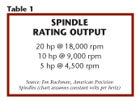
In the stone processing industry, conventional wisdom has always echoed the old car racer's belief that there is no substitute for horsepower: i.e., the more horsepower, the faster and more rugged the racecar. Translated to stone processing, it means the more horsepower, the faster and more effective the CNC cutting and/or polishing machine.
A variation of this old bromide in the industry is the belief that the more sophisticated and advanced the CNC machine's software, the more accurate and higher quality the cut.
While both contentions are widely held because they appear self evident, both are basically wrong in many cases. In reality, “Bigger is not always better.â€
The electric spindle, for example, is one of the most important components of any CNC machine, and spindle horsepower is a measurement of the spindle's ability to effectively cut and shape a particular material type. Yet each material - such as metal, glass, plastic, aluminum, granite or marble - requires different processing speeds.
That speed is dictated by the tool manufacturer's recommended feed rate (linear movement speed) and the rpm rate recommended for the tool being used. For instance, in the case of a typical Tyrolit Vincent V-30 3-cm Position One bullnose, the recommendation for cutting granite calls for:
- feed rate of 800 to 1,000 mm/minute
- rpm rate of 4,500 to 4,600
- final polish wheel rate of 2,500 to 3,000 rpms
In the preceding example, the work is being performed by a spindle rated at 20 hp, yet the project never requires more than 4,500 rpm to cut and polish the granite - actually only about 5 hp. The fact is that for virtually all stone cutting jobs, a 7.5-horsepower spindle is more than sufficient, yet most spindles are built to be capable of processing a wide variety of materials, many of which require much higher spindle speeds than those typical for stone cutting.
The obvious question: “Why do I need a 20-hp spindle for projects that never need more than a quarter of their potential?â€
The real question that needs to be asked when purchasing a CNC machine for stone processing applications is, “What is the horsepower of this spindle at 4,500 rpm?†I recommend that you ask to see written proof for all manufacturers' claims in this regard. In any event, the answers could save you a significant amount of money.
A second important consideration in CNC purchasing decisions concerns the software and its programming. How simple is the CNC to program and operate? How sophisticated does it need to be for stone processing applications? Will any job ever use more than three axes?
Most CNC usage in the U.S. is for the production of kitchen countertops or bathroom vanities, which is two-dimensional work and only requires three-axis operation. In considering a CNC purchase, you should buy a machine that fits your needs and not invest in advanced functions that none of your jobs will ever require.
Advanced, more sophisticated functionality in a CNC machine may not only mean higher and unnecessary price tags, but all too often translates into needless complexity and difficult programming.
In making your next CNC purchase, make sure the machine will produce the intended work, is easy to program and operate, and - most importantly - has a spindle specifically designed for use with marble and granite.